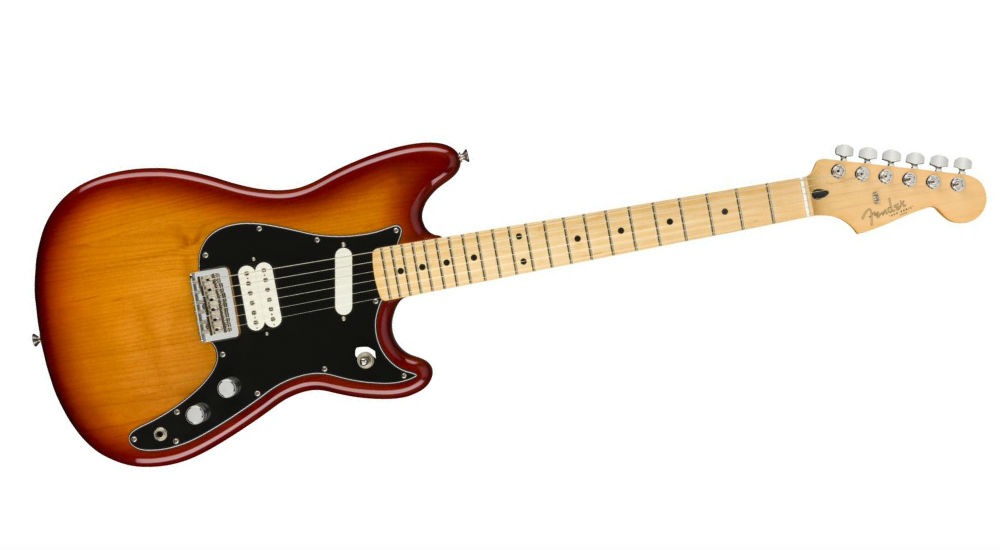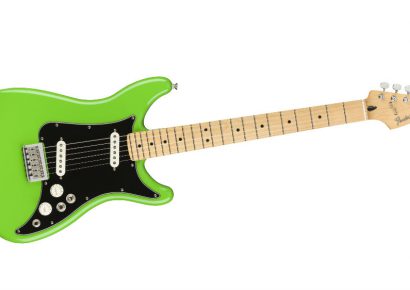In many ways the spiritual ancestor to Fender mainstays like the Mustang and Lead series, the Duo-Sonic was a guitar which despite a brief initial run, has continually grown in stature and popularity – its cool aesthetic and diminutive sizing making it the Fender de jour for the nascent proto-punk and underground rock scenes of the ‘70s and ‘80s right through to the grunge boom of the ’90s and beyond. It didn’t take long before the brains trust at Fender realised the potential of the beloved model and in the time since have gone about gradually reintroducing the popular and practical Duo-Sonic into its revered line-up.
On first impressions, the new Player Series Duo-Sonic is an incredibly classy, compact and endlessly playable guitar, its nimbleness and comfortable neck giving it an instantly natural feel in hand – but these physical traits are only half the story. After spending a bit of time and putting the Duo-Sonic through its paces, it leaves a much more lasting impression, especially in terms of overall sound profile. With three pickup positions including push/pull coil-splitting on the humbucker, working to provide a surprising amount of tonal versatility from its two pickups, the Duo-Sonic is a guitar that continually impresses with its ability to work across a broad range of styles.
Traditionally, the main allure of the Duo-Sonic has been its shorter scale length, medium jumbo-sized frets, and enticing price point. In practice, however, it’s the other dimensions that really come to the fore, and it doesn’t take long for one to become enamoured with the Duo-Sonic’s unique body shape and ergonomic C-shaped neck profile.
When comparing the original 1956 release and the Player Series version, the millennial models have six-saddle strings-through Strat hardtail bridges, as opposed to the vintage style saddles of yesteryear that gave a little less control over intonation. An added feature to modern Duo-Sonics is the headstock truss adjustment indicated by its skunk stripe along the back. Luckily for us, after the 1993 re-release Fender returned to pick up covers, and chrome knurled tone and volume knobs rather than plastic, in turn giving a much cleaner and hardier aesthetic.
The range comes with a specific selection of finishes, including both block colours and transparent options. This Sienna Sunburst is one of six options; of which you can see the neat, mildly figured alder body beneath. The black pickguard is a nice contrast against the bright maple neck, but brighter block colour finishes such as Surf Pearl sport a beautifully figured pau ferro fingerboard and white pickguard. The consideration to detail from Fender, right down to the “F”-stamped neck plate for its sustain-suspending bolt-on neck, never ceases to impress.
As far as playability goes the rumours are true, the guitar is much easier to bend and manoeuvre due to its shorter scale, making the tension of the strings slinkier. Although any good teacher should tell you, it’s all in the technique. The C-shaped neck profile feels incredibly comfortable with a smooth satin polyester finish, fills the palm nicely – for me at least. It also sports an extended scale length neck from what was a 22.5” to a far more familiar 24”, accommodating for its otherwise slim stature.
The Duo-Sonic was known for its specially voiced pickups, with the neck single coil slanting downwards to boosting the presence in the upper midrange. As anyone would expect of a Fender guitar, the neck position can give beautiful, bright cleans but the intricate, nuanced sound of the humbucker provides some real grit no matter what amp it’s played through.
The flexibility in sound of the HS is truly an appealing quality, the knobs offer a great scope and diversity. In rolling off just a little on the tone knob you can have beautiful glassy sounds, and then crank it up for some serious bite! Adjusting the volume knob changes the sound drastically yet again, making it perfect for not only layering upon loops and practicing solos, but along with the three pickup positions available, a great embodiment of alternative rock, surf and even folk.
Although Kurt Cobain was primarily known for playing Mustangs, he was more than familiar with the Duo-Sonics obvious upside, and along with indie queen Liz Phair, these two were perhaps the primary figures in the Duo-Sonic’s resurgence throughout the grunge era. Even prior to this, the Duo-Sonics legacy had already been etched in indie lore with legends like Television’s Tom Verlaine, David Byrne of Talking Heads and legendary songstress Patti Smith giving the Duo-Sonic the kind of CV that is sure to impress anyone into the intelligent, artful side of the rock canon.
After spending a bit of time with the Duo-Sonic, I’m kicking myself for not having gone down the small-scale Fender offset route earlier. Through my formative years studying music, the sheer comfort and overall wieldiness would have been a liberating asset to say the least, and in this respect I can see the Duo-Sonic being an awesome tool for learning chord shapes and scale patterns. While I can’t turn back time, I can still appreciate the awesome playability, unique singular voicing and stylish combination of classic retro body with quality modern fittings that typify the new Player Series Duo-Sonic’s. It’s a level of comfort and uniqueness that is more than worthy of remark.
They do say fashion trends always tend to circle back with time, and with this in mind, it’s easy to see that the classic offset body, demurely ergonomic neck and versatile pickup configuration of the Duo-Sonic has never been more appropriate than it is for right now.

